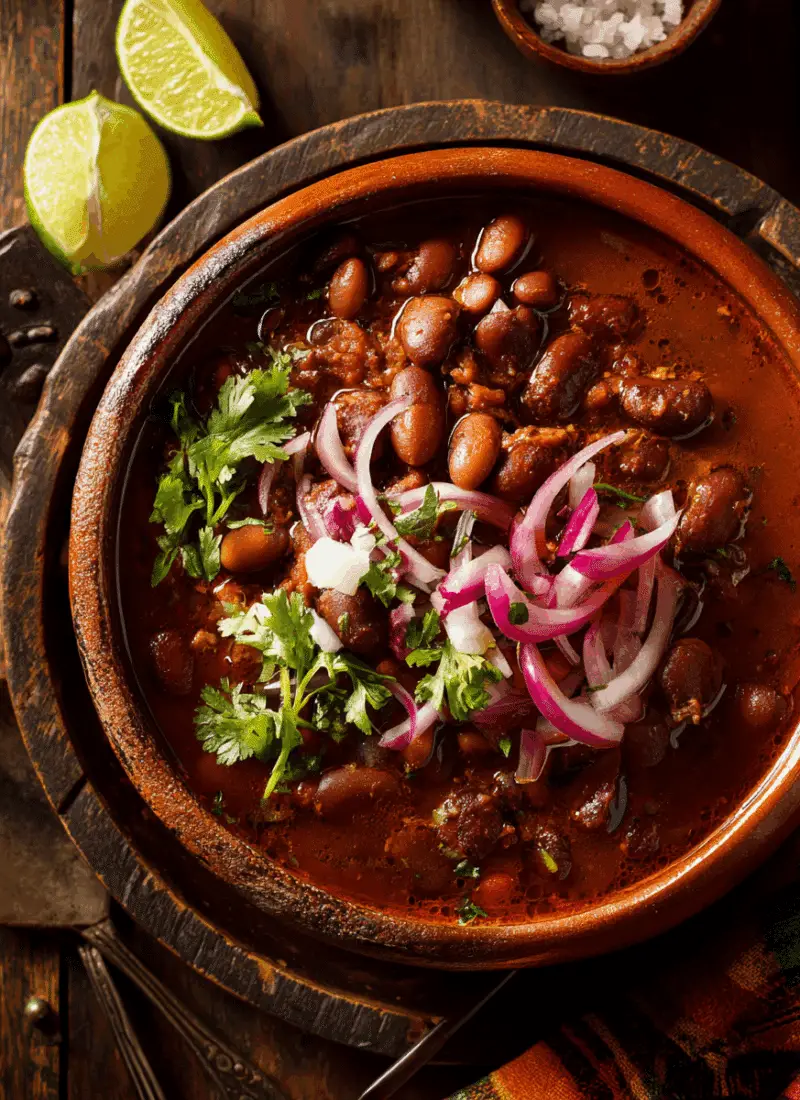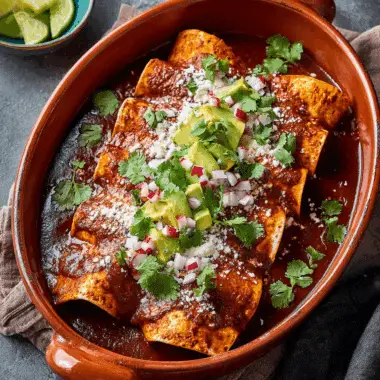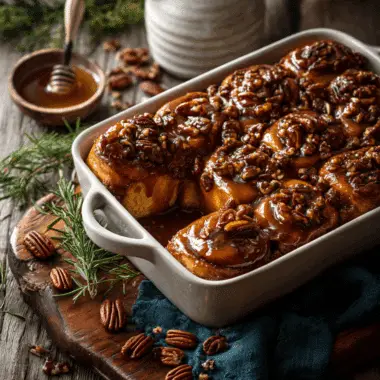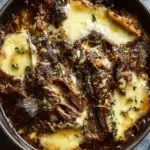Frijoles de Olla, which translates to “beans in a pot,” is a traditional Mexican dish that has been a staple for generations. This simple yet flavorful stew is typically made with pinto or black beans, simmered slowly with aromatic herbs and seasonings until tender. It’s a comforting and nourishing dish often served during Mexican Independence Day celebrations, symbolizing warmth, unity, and the essence of home cooking.
FULL RECIPE
Ingredients
- 2 cups dried pinto beans (or black beans), rinsed and sorted
- 8 cups water
- 1 medium white onion, halved
- 3 garlic cloves, peeled
- 1 bay leaf
- 1 teaspoon dried oregano (Mexican oregano preferred)
- 1 teaspoon salt (or to taste)
- 1 fresh epazote sprig (optional, for authentic flavor)
- 1–2 serrano peppers (optional, for heat)
- Fresh cilantro, chopped (for garnish)
- Lime wedges (for serving)
Directions
- Prep the beans – Rinse the dried beans thoroughly and remove any debris. Optional: Soak them overnight in water for quicker cooking.
- Start cooking – In a large pot or traditional clay pot (“olla”), add the beans and 8 cups of water. Bring to a boil over medium-high heat.
- Add aromatics – Once boiling, add the halved onion, garlic cloves, bay leaf, and oregano. Reduce the heat to low and simmer gently.
- Simmer until tender – Cook the beans for about 1.5 to 2 hours (or 45 minutes in a pressure cooker), checking occasionally to ensure they remain submerged in liquid. Add more hot water if needed.
- Season – When the beans are almost tender, add the salt, epazote (if using), and serrano peppers (if you want a spicy kick). Continue cooking until beans are fully soft and flavors are well blended.
- Serve – Ladle the beans and broth into bowls, garnish with fresh cilantro, and serve with lime wedges. Enjoy them with warm tortillas or rice for a complete meal.
Nutrition Facts
- Calories: 180
- Protein: 10g
- Carbohydrates: 33g
- Dietary Fiber: 12g
- Sugars: 1g
- Fat: 1g
- Saturated Fat: 0g
- Cholesterol: 0mg
- Sodium: 300mg
- Potassium: 600mg
Nutritional Value and Health Benefits
This dish is not just comforting but also nutrient-dense, offering an excellent source of plant-based protein, complex carbohydrates, and dietary fiber. Pinto or black beans, commonly used in Frijoles de Olla, are rich in essential minerals like potassium, magnesium, and iron. They are also low in fat and contain no cholesterol, making them heart-healthy. The fiber content aids digestion and promotes satiety, making the dish suitable for those managing weight or blood sugar levels. With added aromatics like garlic and onion, the stew gains additional antioxidant and anti-inflammatory benefits, enhancing its role as a wholesome, everyday meal.
Regional Variations Across Mexico
Frijoles de Olla can vary greatly depending on the region of Mexico where it’s prepared. In the central highlands, cooks often incorporate fresh herbs like epazote, which imparts a distinctive earthy flavor. In northern Mexico, beans may be cooked with pork fat or chorizo for a richer taste, while in coastal areas, seafood-infused versions sometimes appear. Some households prefer black beans, especially in southern states like Oaxaca and Chiapas, while others use pinto beans almost exclusively. These regional adaptations highlight the flexibility of the recipe and how local ingredients influence its flavor profile.
Serving Suggestions and Presentation
When served as the centerpiece of a meal, Frijoles de Olla is best enjoyed in deep bowls, accompanied by warm corn tortillas for dipping. Garnishing with chopped cilantro, diced onions, or fresh jalapeños can add bursts of flavor and visual appeal. Lime wedges on the side provide a refreshing citrus contrast, enhancing the dish’s overall brightness. For special occasions, the stew can be presented in a traditional clay pot, not only for authenticity but also because the material retains heat exceptionally well, keeping the beans warm for extended gatherings.
Perfect Pairings with Other Dishes
Frijoles de Olla pairs beautifully with many Mexican classics. It complements grilled meats like carne asada or chicken fajitas, as the earthy bean flavors balance the smokiness of the meat. It also works as a hearty side dish to accompany enchiladas, tamales, or tacos. For a vegetarian-friendly spread, pair the stew with grilled vegetables, guacamole, and fresh salsa. The broth from Frijoles de Olla can even be served as a light soup before the main course, making it a versatile addition to various meal plans.
Tips for Enhancing Flavor
While the traditional preparation is delicious on its own, there are numerous ways to deepen the flavor of Frijoles de Olla. Toasting the beans briefly before adding water can enhance their nutty undertones. Using homemade vegetable or chicken stock instead of plain water creates a richer base. Adding smoked paprika or chipotle peppers introduces a subtle smokiness. Fresh herbs like oregano and cilantro stems can be simmered with the beans for a layered aromatic profile. Even the choice of cooking vessel—such as a clay pot versus a metal saucepan—can subtly alter the taste and texture.
Storage and Reheating Advice
Frijoles de Olla stores well, making it ideal for meal prepping or batch cooking. Once cooled, the beans and their broth can be refrigerated in airtight containers for up to five days. For longer storage, they can be frozen for up to three months, though it’s best to portion them out before freezing for easier reheating. When reheating, gently warm the beans over low heat, adding a splash of water or broth to restore moisture. Avoid rapid boiling, as this can cause the beans to break apart and lose their shape.
Adapting for Special Diets
This dish naturally fits into vegetarian and vegan diets, but it can also be adapted for other dietary needs. For a lower-sodium version, use less salt during cooking and season the beans just before serving. Those following gluten-free diets can enjoy Frijoles de Olla without any adjustments, as all ingredients are naturally gluten-free. If a higher-protein version is desired, adding quinoa, lentils, or chopped nuts during cooking can boost protein content without altering the flavor too drastically.
Using Leftovers Creatively
Leftover Frijoles de Olla can be transformed into entirely new dishes. Mashing the beans and frying them in a skillet turns them into refried beans, perfect for burritos or tostadas. The bean broth can be used as a base for soups or as a cooking liquid for rice, imparting rich flavor. Leftovers can also be blended with spices to make a hearty bean dip for chips or raw vegetables. These repurposing ideas not only reduce food waste but also make weekly meal planning more exciting.
Traditional Cooking Vessels and Methods
Traditionally, Frijoles de Olla is prepared in a clay pot, which imparts a subtle earthy flavor to the beans. Clay pots distribute heat evenly and retain it well, making them ideal for long, slow cooking. In modern kitchens, a heavy-bottomed pot or Dutch oven works just as well, though the flavor may differ slightly. Some cooks prefer using pressure cookers or slow cookers to save time without sacrificing tenderness. Regardless of the method, the key is low and slow cooking, allowing the beans to absorb the seasonings fully.
Conclusion
Frijoles de Olla is far more than just a bean stew it’s a dish that carries cultural heritage, nutritional value, and boundless versatility. Whether served during a festive celebration or as a humble family dinner, it offers warmth, nourishment, and a connection to tradition. Its adaptability to different regions, dietary needs, and flavor preferences makes it a timeless recipe in Mexican cuisine. By understanding its roots, exploring variations, and learning how to store and repurpose it, you can keep this cherished dish a regular part of your cooking repertoire while honoring the traditions that have kept it alive for centuries.








